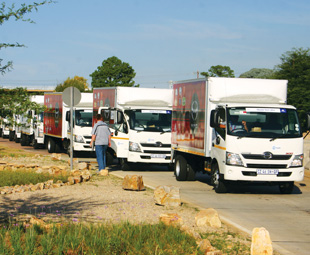Hino puts its best to the test

Truck Test 2014 once again challenged manufacturers to put their finest vehicles to the test. We speak to Hino about how it took up the challenge
Hino entered an impressive number of vehicles this year – the Hino 300 714 (6 500 kg gross vehicle mass (GVM)), 815 (7 300 kg GVM) and 915 (8 500 kg GVM) joined Truck Test 2014. The Hino 300 Series and its predecessor – the Toyota Dyna – have been dominant players in the medium commercial vehicle (MCV) segment in South Africa for more than 20 years.
Gert Agenbag, product planning and development manager for Hino South Africa, is impressed with the positive changes that were implemented at this year’s test: “Following the feedback given to the organisers after the 2013 event, the changes that were brought about ensured that Truck Test 2014 was well organised and executed. This provides grounds for trust that future events will add even more value.”
 Hino decided to participate in the Truck Test again because, as a major role player in this segment of commercial vehicles, the company saw the test as an opportunity to showcase its product range and its confidence in the vehicles’ performance and capabilities.
Hino decided to participate in the Truck Test again because, as a major role player in this segment of commercial vehicles, the company saw the test as an opportunity to showcase its product range and its confidence in the vehicles’ performance and capabilities.
Agenbag has noticed some changes as Truck Test has evolved over the last few years: “It is becoming more competitive every year – this is a testament to the organisers that they are succeeding in making this annual event a reputable test, which the industry recognises and uses for reference purposes.”
He adds that Truck Test 2014 will have considerable benefits for the industry – both for the manufacturers and their customers: “With the combined impact of environmental and pricing issues affecting fuel usage, an unbiased source of fuel consumption comparisons will enable fleet operators to target achievable fuel consumption levels. This will improve operating efficiencies and help address carbon emission targets set by government.”
Agenbag continues: “The fuel consumption results that were achieved were set by skilled drivers under equal and real conditions. Fleet operators can base their own fuel consumption targets on this information, but they also need to accept that drivers make the difference. Hino is of the belief that by educating drivers to be highly fuel-consumption conscious, their more controlled behaviour will reduce the incidence of other speed-related problems, such as brake and tyre wear and tear, and accidents.”
Agenbag notes that one of the main differences between last year’s test and Truck Test 2014, was the longer, unobstructed test route. “This ensured that all trucks operated within the same time frame and conditions, which results in greater confidence in the outcome of the test.”
He concludes: “Truck Test 2014 provided a fair and pleasant environment, which ensured that the test was conducted in a professional manner and that the results are believable.”
Published by
Focus on Transport
focusmagsa




